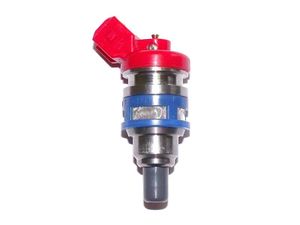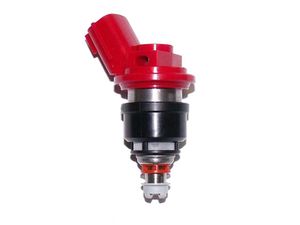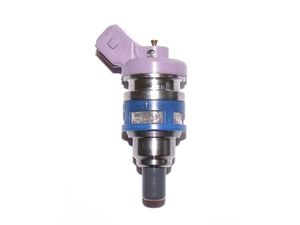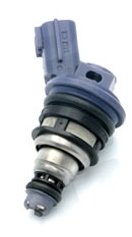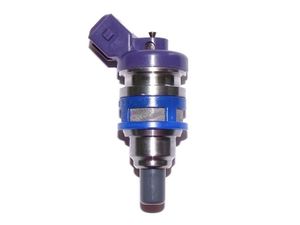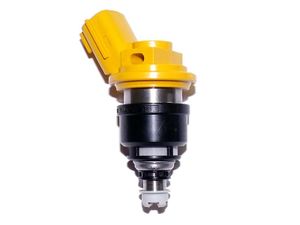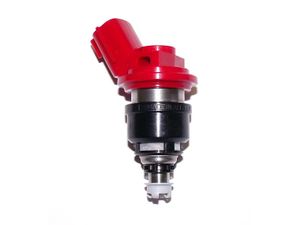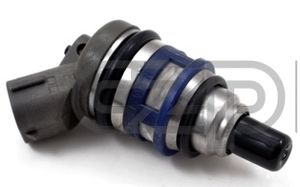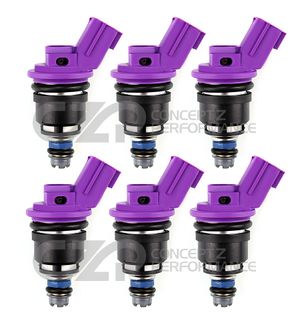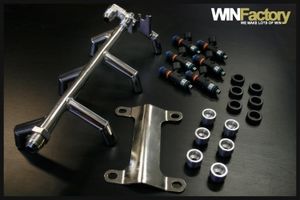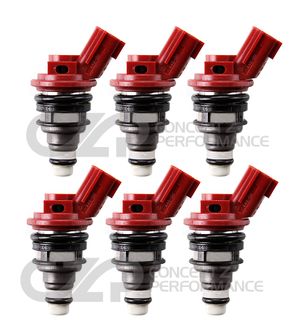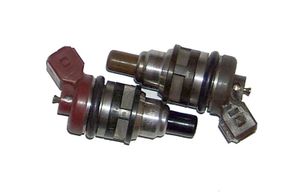Fuel Injector
A fuel injector is a device used to inject a specified amount of fuel into the intake of an engine as air enters a cylinder, creating the air/fuel mixture.
Fuel injectors vary widely by a car's make and model. This article primarily concerns itself with those found, of course, in the Z32.
Related articles: Fuel Injector Testing; Fuel Injector Replacement
Contents
Versions & Differences
The Z32 uses high-impedence, side-feed fuel injectors. New fuel injectors ohm test at approximately 11.4 ohms. Operating range is between 10 and 14 ohms.
The table below illustrates the different types of fuel injectors available for the Z32.
| |
Phase I (Old Style) |
Phase II (New Style) |
Additional Notes |
| 270CC (Stock NA) |
New style are also found on the Infiniti J30. | ||
| 370CC (Stock TT) |
Purple injectors tend to turn grey & brown over the years. OEM replacements usually have a dark blue dot on the connector and are slightly ligher in color compared to NISMO 555s. New style is also found on some years of the Infiniti Q45. | ||
| 555CC |
|
NISMO did not introduce a P2 555CC injector, but instead introduced P2 615CC and 740CC models. | |
| 615CC |
|
See above. Some people refer to these as 555s, but that is not correct, and they are not interchangeable with 555s. These actually flow 600cc and have a lower latency value than many other injectors.. | |
| 740CC |
|
| |
| JECs Injectors (available in various sizes). |
Varies |
JECS injectors beyond 270cc or 370cc are redrilled injectors. The old-style connectors are visually similar to P2 Nissan connectors, but the alignment slots are different, so they require Denso/SARD/PE style connectors. Old-style JECS injectors, despite the new connector, are still old-style injectors. | |
| Deatschwerks |
|
Deatschwerks Injector |
Deatschwerks injectors were originally redrilled remanned cores, and often resembled OEM injectors for this reason. Newer Deatschwerks injectors start with a new core (American Standard), but are still redrilled. They are either bright red or bright purple. |
Note: Deatschwerks injectors are also available (in 270CC, 370CC, 550CC, and 740CC flow rates). As they are redrills of stock injectors, they all look like either P2 270CC or 370CC injectors. Early Deatschwerks injectors have been seen as redrills of used NA or TT injectors and therefore can be found as either purple or red, and were redrilled used injectors. Newer Deatschwerks injectors are redrilled new OEM or like-OEM 370CC (TT) injectors, if higher flow-rates than 370CC.
Thanks to CZP and Z1 for the above pictures.
Other Z32 Injectors
The above table illustrates only injectors that will fit in a VG30 with no [major] modifications. There are a few other options, such as:
| Sard 850CC Injectors (Requires different fuel rail or adapters). |
|
| DrivenAuthority/WINFactory Top-Feed Fuel Rail Kit (Uses EV14 Injectors, available in various sizes from 545CC to 1200CC). |
|
| BDE Top-Feed Fuel Rail Kit Also uses ID Injectors. There are two versions currently on the market. The older style requires machining of the lower plenum, but maintains stock fuel injector depth. This style requires 60mm long injectors with 14mm O-rings; Purple ID adapters. These part numbers will be formatted as: xxxx.60.14.14 (Where xxxx is the flow rate in cc/min) The later style uses bolt-in lower plenum adapters. This version uses 48mm injectors with 14mm O-rings, which are the same style the WinFactory rails use.The ID725 and 1000 will not require any adapter, while the 850, 1300, and 2000 will use the gray ID adapter. These part numbers will be formatted as: xxxx.48.14.14 (Where xxxx is the flow rate in cc/min). |
|
| Phase "1.5" Injectors. Some generations of JECS redrills used an in-between style with a new-style body and JECS/Sard/Denso/PE style connector, but the body was still based on the old-style injectors, so the fuel screen was around the coil rather than below it. This made it susceptible to ethanol damage, so they were still as unreliable as the early style injectors. |
Phases 1 and 2
Phase I fuel injectors were prone to corrosion on their electrical connectors as well as internally--ethanol in today's fuels quickly erodes the connections to the solenoid coil and causes premature failure (this can be verified by ohm-testing a fuel injector).
Mid-cycle, Nissan switched to a superior "Phase II" later style of fuel injectors, which has a revised design featuring sealing electrical connectors and a "pintless" design less susceptible to failure caused by ethanol content in fuel. See the table below for info about when specific years/models made the switch.
| Year |
Non-Turbo |
Convertible |
Twin Turbo |
| 1990 |
Phase 1 |
Phase 1 |
Phase 1 |
| 1991 |
Phase 1 |
Phase 1 |
Phase 1 |
| 1992 |
Phase 1 |
Phase 1 |
Phase 1 |
| 1993 |
Phase 2 |
Phase 1 |
Phase 1 |
| 1994 |
Phase 2 |
Phase 2 |
Phase 1 |
| 1995 |
Phase 2 |
Phase 2 |
Phase 2 |
| 1996 |
Phase 2 |
Phase 2 |
Phase 2 |
Nismo 615s and 740s
Nismo 740cc injectors are considered the "gold standard" for the 300ZX. They are the only direct-fit injector that is manufactured at 740cc, all others are redrilled at the time of this writing, which means the Nismo 740 is more reliable and consistent. These offer the following advantages:
- Manufactured at 740cc (not redrilled)
- New-style reliability & connector
- Ethanol compatible (new style)
- High power ceiling (over 700whp)
- 4-port metering plate (better atomization)
- Like-stock idle behavior.
It's worth mentioning that Nismo does not actually manufacture injectors, the cores are by JECS and the injector itself is manufactured by HKS or Tomei. It is often cheaper to buy them directly from a manufacturer like Tomei, despite it being the exact same part.
Nismo 615s are also a popular option. They are virtually identical to 740s, but use a yellow top (instead of red found on the 740s) and flow less fuel. For the price, 740s are a better choice as they often cost less than 615s, move more fuel, and idle just as well.
Flow-Testing
I had a set of Nismo 740s and a set of Nismo 615s independently flow-tested. The Nismo 740s were a brand new set, and we had them flow tested by three different companies to compare their results.
| Nismo 740 (Tested at 3 bar) | |||
| |
AUS |
RC Eng. |
JWT |
| 1 |
752 |
741 |
735 |
| 2 |
749 |
740 |
740 |
| 3 |
752 |
739 |
737 |
| 4 |
749 |
742 |
732 |
| 5 |
739 |
740 |
732 |
| 6 |
739 |
740 |
730 |
| High |
752 |
742 |
740 |
| Low |
739 |
739 |
730 |
| Average |
746.67 |
740.33 |
734.33 |
| Latency |
|
Untested |
0.84ms |
As I found their testing to be the most consistent and reliable, I only had RC test the Nismo 615s out of curiosity.
| Nismo 615 | |||
| 1 |
|
602 |
|
| 2 |
|
599 |
|
| 3 |
|
600 |
|
| 4 |
|
601 |
|
| 5 |
|
600 |
|
| 6 |
|
599 |
|
| High |
|
602 |
|
| Low |
|
599 |
|
| Average |
|
600.17 |
|
| Latency |
|
Untested |
|
Retrofitting
As you can see from the above pictures, P1 and P2 injectors use physically different dimensions (and electrical connectors). This means that one cannot simply drop P2 injectors in a P1 fuel rail. Further, a P2 fuel rail will not fit a P1 lower intake manifold, and a P2 lower intake manifold will not fit P2 heads. The (proper) possible ways to install P2 injectors into a P1 engine are:
- Using an adapter kit, which uses special bushings that allow P2 injectors to seat into P1 fuel rails.
- Using a 300Degree Fuel Rail, for which there is a version that accepts P2 injectors and seats into a P1 lower intake manifold.
- Replacing fuel rails, lower intake, and heads with P2 (new-style) counterparts.
Electrical connectors can be cut/spliced to install the P2 versions. Another popular option is to replace the wiring harness (which is relatively common practice anyways) with that for a P2 model year. For example, installing a '95 harness in a '90 which has P2 injectors retrofitted in. However, this is costly and also requires swapping a few other components (or their connectors).
When using an adapter kit, it is almost always necessary to grind a small amount of material away on the "bridge" over cylinder 1's injector. This is because the adapters raise the injector slightly in its seat, and without doing so, there isn't room for the electrical connector.
Appearances & Identification
Z32 injectors tend to change colors over the years. This is similar to how Super Nintendo consoles all turn yellow over the years. They're not dirty, it's just a chemical reaction with the plastic.
NA injectors darken slightly, whereas TT injectors will darken, turn green, and eventually turn a greyish brown. Scuffing up the plastic a bit will usually reveal a little bit of purple plastic underneath.
370cc vs 555cc
Confusion between identifying used old-style 370s and used 555s is common, because they're both purple. When brand new, the 370cc injector is a slightly lighter tint of purple, but they darken quite quickly after installing and, without seeing them side-by-side, are almost identical visually to 555s.
A good rule of thumb, however, is to remember that replacement 370cc injectors have a blue dot on the top, where the connector clips on (you'll need to remove the connector to see). If you have a purple injector that has no dot, it's probably a 555. If there is a dot, it's a 370. If there's no dot, but it's not purple (it's brown/green), it's probably an original 370.
270cc vs 740cc
270cc and 740cc injectors are, from the top, visually identical. However, 740cc injectors have a black ring on the bottom, while 270s have a red ring. This ring is not visible with the injector in the rail. It's also quite uncommon to install high-flow injectors in NAs, and NA injectors in TTs. Not to say it's never happened, but it's very rare (and not a great idea to begin with).
Keep in mind, too, that upgraded injectors require an upgraded ECU to function correctly. If in doubt, you can have the injector(s) flow-tested.
